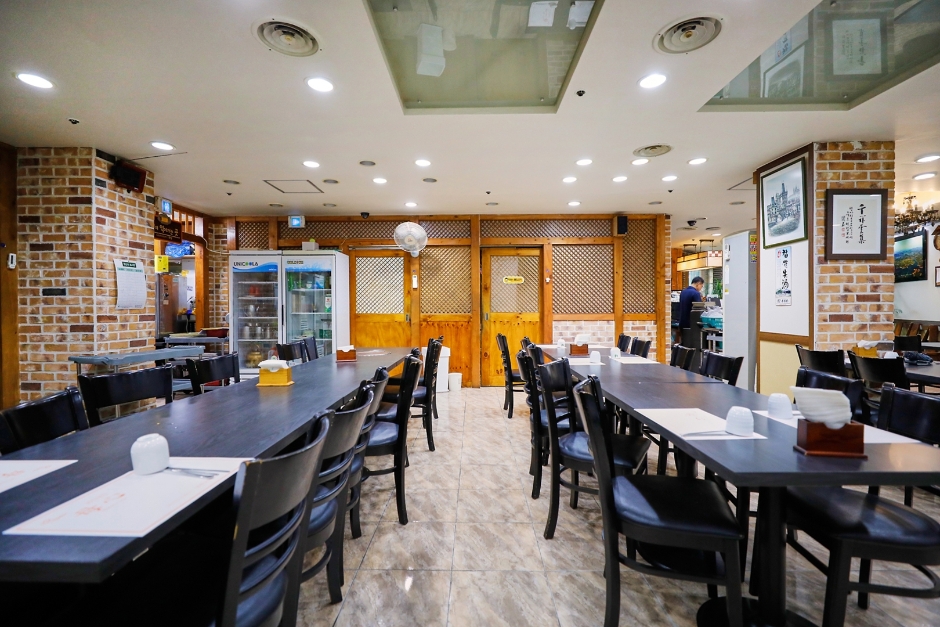Nature Collection - Gwanghwamun Branch [Tax Refund Shop] (네이처컬렉션 광화문)
8.7Km 2024-04-18
1F, 105, Saemunan-ro, Jongno-gu, Seoul
-
Donggwol Maru - Korea Cultural Heritage Foundation Branch [Tax Refund Shop] (한국문화재재단 동궐마루)
8.7Km 2024-10-15
99, Yulgok-ro, Jongno-gu, Seoul
-
ABC-Mart - Cheonho Branch [Tax Refund Shop] (ABC마트 천호점)
8.7Km 2024-04-18
7, Cheonho-daero 157-gil, Gangdong-gu, Seoul
-
Sarangchae (사랑채)
8.7Km 2016-12-30
6, Insadong 16-gil, Jongno-gu, Seoul
+82-2-737-1155
Sarangchae is located in Insa-dong, one of the most famous neighborhoods visited by tourists. Majority of the restaurant's customers are foreigners, and they offer reasonably priced Korean dishes that are highly popular among foreign visitors.
Godiva - Gwanghwamun Branch [Tax Refund Shop] (고디바 광화문점)
8.7Km 2024-04-22
1F, to 3F, 159, Sejong-daero, Jongno-gu, Seoul
-
Olive Young - Mapo Station Branch [Tax Refund Shop] (올리브영 마포역)
8.7Km 2024-04-18
1F, #115, 53, Mapo-daero, Mapo-gu, Seoul
-
Unhyeongung Royal Residence (서울 운현궁)
8.7Km 2024-03-04
464, Samil-daero, Jongno-gu, Seoul
+82-2-766-9090
Located near the Gyeongbokgung Palace, Unhyeongung Palace was a residence of royalty in Joseon period. It was the place where Gojong (1582-1919, reign 1864-1907), king of Joseon (1392-1897) and emperor of the Korean Empire (1897-1910), was born in, as well as the place where Heungseon Daewongun (1821-1898), his father, had resided in. Buildings include Noandang Hall, Norakdang Hall, and Irodang Hall. The Royal Residence offers programs like traditional weddings and traditional culture experiences, while the exhibition hall showcases Joseon-era artifacts.
Mosim (모심)
8.7Km 2025-05-20
8 Gaeunsa-gil, Seongbuk-gu, Seoul
Mosim is a Korean table d’hote restaurant that offers a variety of menus to choose from depending on the kind of dishes and the number of side dishes. The set menu, which includes main dishes, such as hwangtae gui (grilled dried pollack) and galbitang (galbi soup), and side dishes, such as salad, japchae, and seasoned vegetables, is plentiful in amount and variety enough to fill the table. There are menu items that can be enjoyed individually, such as samgyetang, bibimbap, and yukgaejang (spicy beef soup). The restaurant’s menu comprises nutritious dishes that soothe one's tired mind and body. The restaurant has private rooms that can accommodate 4, 8, 12, 16, 20, 24, and 30 people, so it is a good option for guests seeking a quiet meal with the family or group gatherings.
Jogyesa Temple (조계사(서울))
8.7Km 2024-10-25
55 Ujeongguk-ro, Jongno-gu, Seoul
As the main temple as well as the district head temple of the Jogye order in Seoul, Jogyesa Temple is the center of Korean Buddhism. The temple was built in the late 14th century during the Goryeo period but was completely destroyed in a fire. It was rebuilt under the name of Gakwangsa Temple in 1910 with the effort of many respectful monks, namely Han Yong-un and Lee Hee-gwang. The temple was given a role as the head temple of Korea’s Buddhism and renamed to Tegosa Temple in 1936. In 1954, a purification drive took place to eliminate Japanese influence and revive traditional Buddhism, which established the present day Jogyesa Temple as a result.
Jogyesa Temple plays an important role in Korean Buddhism as the head temple of the Jogye order. Jogyesa Temple’s Dharma Hall serves as the main venue for several Buddhist events, holding rituals, lectures, ceremonies, and other events all year long. The annual lantern festival in celebration of Buddha's birthday also takes place at this temple.
![Nature Collection - Gwanghwamun Branch [Tax Refund Shop] (네이처컬렉션 광화문)](http://tong.visitkorea.or.kr/cms/resource/54/2888854_image2_1.jpg)

![ABC-Mart - Cheonho Branch [Tax Refund Shop] (ABC마트 천호점)](http://tong.visitkorea.or.kr/cms/resource/79/2878879_image2_1.jpg)
![Godiva - Gwanghwamun Branch [Tax Refund Shop] (고디바 광화문점)](http://tong.visitkorea.or.kr/cms/resource/25/2878225_image2_1.jpg)
![Olive Young - Mapo Station Branch [Tax Refund Shop] (올리브영 마포역)](http://tong.visitkorea.or.kr/cms/resource/94/2888894_image2_1.jpg)


 English
English
 한국어
한국어 日本語
日本語 中文(简体)
中文(简体) Deutsch
Deutsch Français
Français Español
Español Русский
Русский